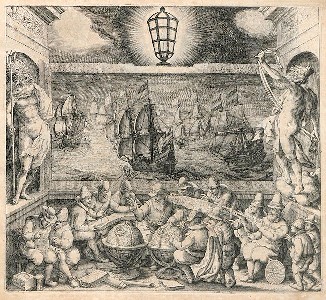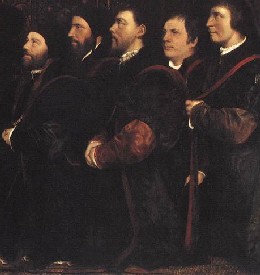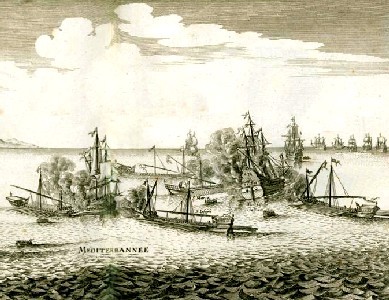
History of Pirate Surgeons Menu: 1 2 3 4 5 6 7 8 9 10 11 12 Next>>
The History of Sea and Pirate Surgeons, Page 2
Pirates and Sea-surgeons in the First Millennium

Artist: Évariste Vital Luminais
Norman Pirates, 9th century (1822)
We now enter a period where I have found little about the role of sea-surgeons, much less pirate surgeons. It is likely that sea-going surgeons at this time would still have been attached to military forces. Pirates usually avoided military entanglements because the military is well prepared for fighting and they typically have little in the way of booty to offer brigands.
Instead, pirates target merchant ships because a) they have goods on board the pirate can resell at a friendly port and b) they are less likely to offer resistance than fighting ships.
A merchant's goal is to get his goods to market as cheaply as possible. When merchants ship products over seas, they typically man a vessel with as small a crew as possible to minimize the cost of shipping. A merchant sailor is not usually trained to fight and is primarily on the ship to earn his living. So when faced with a pirate, a merchant sailor is less likely to fight, especially on a lightly-manned ship where he wouldn't have much support.
Another factor that impacted the need for sea-surgeons at this time involves navigation. Until about the 15th century AD, navigation was performed by following coasts, staying within established routes and performing rudimentary

Book frontispiece for "
The Light of Navigation" (1608)
celestial navigation.1 This usually meant staying in sight of the shore. As long as merchant ships could remain near friendly, inhabited shores, there was little reason for them to incur the expense of a professional like a surgeon on board.
In addition, medicine as a profession was discouraged by many of the religious organizations who held so much sway at this time. There were very few medical "professionals" around for a merchant to hire to accompany his ship. Most Christian medicine up until the beginning of the next millennium was performed by priests and monks. Lay people weren't officially allowed to practice medicine until 1130 when the Council of Clermont decreed that priests and monks could no longer do so.
Adding all these factors together, it seems unlikely that merchant ships would have

Artist: Hans Holbein the Younger
From Henry VIII and the Barber Surgeons (1543)
a doctor on board in the first millennium. Since they were the primary targets of the pirates, it is also unlikely the pirates would have
acquired surgeons from them as they did in later ages. If the pirates had a healer on board, that individual would have to have been brought with the pirates. However, like the merchants, the pirates usually stayed near friendly ports in the Mediterranean and attacked the merchant vessels who passed through their area. Thus, evidence suggests that pirates and merchant seamen went back to land when surgery was required rather than carrying a surgeon with them.
Zachary Friedenburg explains how surgeons first found their place on English ships at this time. "By the eleventh century, barber-surgeons had taken over the task of surgery in the Mediterranean navies and were known in Italy as barbariers, and their assistants barbarietos. Barbariers accompanied ships trading with England, and the practice of appointing barber-surgeons to ships spread to English ships."2 The passing of the medical baton in the new millennium created the conditions where sea-surgeons could officially be recognized.
1History of navigation, http://en.wikipedia.org/wiki/History_of_navigation, gathered 6/18/12; 2Zachary Friedenberg, Medicine in the Age of Sail, p.1-2
Mediterranean Corsairs, Pirates and Medicine
When the Knights of Rhodes (Malta) became corsairs of the 14th century to protect Christian commerce from

Naval Battle between the Maltese and Turks in the Mediterranean Sea (1707)
Mediterranean piracy, they took their surgeons with them. The University of Malta website tells us that "no galley or sailing ship left the islands' shores without a barber surgeon on board."1 They explain that, "wounded men were never in short supply owing to their fighting seafaring activities in the Mediterranean… Surgeons had to spend time on the Order's galleys before being able to secure a position in the hospital."2 So the idea of battle and sea-surgery as a training ground for surgeons can be traced back to the dawn of the Renaissance.
One of the goals of the Barbary Corsairs whom the Knights were fighting was to provide slaves to North Africa. A surgeon taken from a ship was of particular interest to the slavers. As Stanley Lane-Poole explains, "When a Corsair has taken a prize and has ascertained, by the application of the bastinado [foot-whip] , the rank or occupation and proficiency of the various captives, he brings them

Artist: Achille Devéria
Portrait of Aruj Barbarossa
before the governor to be strictly examined... Drawn up in a row, one in eight is chosen by the Dey [ruler of a state] for his own share, and he naturally selects the best workmen, and the surgeons and ship's masters, who are at once sent to the Government bagnio [bath-house].3
Two of most famous Barbary Corsairs were the Barbarossa Brothers Aruj and Hizir (Kheir) who were born in Greece in the 1470's. Aruj began his pirating career in Lesbos and joined his brother Hizir after he was ransomed by the Knights. The Barbarossas moved their operations to the Western Mediterranean around 1505. It was here in 1512 that Aruj's left arm was shot away by a cannon. "He was rushed to Tunis for surgical treatment with his left arm in tourniquet."4 Following the arm's amputation, Aruj was fitted with a silver prosthetic, adding color to his reputation. From that point on, he was nicknamed Gümüş Kol (or 'Silver Arm' in Turkish). Note that, at least in the case of these two Barbary Corsairs, land appears to have been the best place for the Barbary pirates to seek medical assistance – possibly from those heathen surgeons the Corsairs had sold into slavery.
1Surgery in Malta, http://www.um.edu.mt/ms/surgery, gathered 6/18/12; 2Ibid; 3Stanley Lane-Poole, The Story of the Barbary Corsairs, p. 121; 4Barbarossa Brothers, https://sites.google.com/site/cutlassescorsairs2008/thebarbarossabrothers, gathered 6/18/12;

